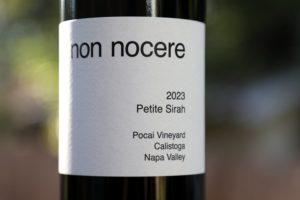
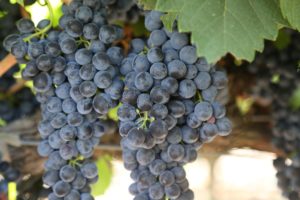 Non Nocere Wine. Non nocere literally translates to, “first, do no harm” and is derived from a version of the Hippocratic Oath. Founder and winemaker Peter Hopkins tries to apply this principle to all avenues of his business including eliminating packaging excesses (no foils and minimizing bottle weights). His wines are both vintage and data driven. And as a result, they are made differently from year to year; this has translated to types of barrels, yeast selection, fermentation management and even the packaging and types of bottles. And that keeps it fun for him and for his customers who aren’t necessarily looking for wines that taste the same every year.
Non Nocere Wine. Non nocere literally translates to, “first, do no harm” and is derived from a version of the Hippocratic Oath. Founder and winemaker Peter Hopkins tries to apply this principle to all avenues of his business including eliminating packaging excesses (no foils and minimizing bottle weights). His wines are both vintage and data driven. And as a result, they are made differently from year to year; this has translated to types of barrels, yeast selection, fermentation management and even the packaging and types of bottles. And that keeps it fun for him and for his customers who aren’t necessarily looking for wines that taste the same every year.
One of the strongest attractions with this micro-brand is its total transparency. And that is uniquely refreshing in a business where winemaking is often presented through rose colored glasses. His wines tell a story of vintage, but there is much more to each story. He enjoys capturing a unique event or moments in time, even if those moments are not always ideal, i.e. harvesting later than anticipated. Everything does not always work out perfectly in winemaking, but his goal is to constantly improve his craft and a significant part of this process involves adaptability, both in the vineyard and the cellar. For Peter, making something tangible that people take great enjoyment in consuming, in the age of the digital culture, is highly rewarding.
He was raised in the small town of Dubois in rural Pennsylvania about a 2 hour drive north east of Pittsburgh. Peter’s undergraduate degree was in neuroscience at the University of Pittsburgh. He realized if he developed a career in this field it would be either in research and as he told us, “working under florescent lights behind locked doors” – the more he thought about it, the less he was enthused about pursuing this path.
While at college he furthered his interest and education in wine. He purchased Jancis Robinson and Hugh Johnson’s, The World Atlas of Wine. He would then frequent some of the state controlled liquor stores in Pennsylvania and would purchase bottles that he found intriguing. He would open both the wine and the book and “take a trip” to where it was produced, learn more about the variety and various winemaking styles. Peter’s family enjoyed wine for dinner, usually a cheap Chianti and often something from Ravenswood. Wine was a part of their meals and conversation, but was never associated with special events.
At one point he wanted to become a doctor, as he admits, perhaps he watched too many shows of Scrubs and Grey’s Anatomy, but eventually the thought of another 4 to 8 years of schooling after graduating with his undergraduate degree, also did not appeal to him. He spent a year working for his father, a lawyer and his uncle, a metallurgist. The company, R-E-D Industrial Products, took the first initials of the three partners’ names, Rodney, Ed and Dave and produce a product called Silica Fume, a type of pozzolanic ash. Peter thought his father nurtured dreams of his son becoming the next Andrew Carnegie, a fine nod to the industrialist who built Pittsburgh’s Carnegie Steel Company, but selling ‘dirt’ and traveling to industrial sites for work, was not the ticket to such unparalleled success.
Peter told us that he went from practicing surgery on rats, to selling dirt from behind a computer screen staring at excel spreadsheets at his father’s law firm, to becoming a winemaker. His fork in the road moment was when he was considering either becoming a product designer or pursuing his interest in wine and moving to Napa Valley.
The more he learned about wine the more he was intrigued about working a harvest. He informed his parents he was moving to California, choosing Napa Valley in particular. He figured he might as well be in the heart of arguably the most well-known wine region in the country. Instead of, “leaving on a jet plane” and being in California in a few years, as he says, quoting the John Denver song, instead he drove across country in a 2007 Camry adding some 2,600 miles to his vehicle.
His first position was working at HUNNICUTT Winery in St. Helena in 2015. Thrown into a custom crush environment, he was quickly exposed to numerous wines, styles of winemaking, winemakers and personalities. It was a learn by doing experience and he made some valuable networking connections. And his own winemaking practices were rooted from both cellar work and conversations with other winemakers and cellar staff while helping make wine for a diversity of clients.
He joined harvest at Frankland Estate in Western Australia in 2016 where he was able to work with both Riesling and Syrah. He returned to Napa Valley and assisted the small but mighty winemaking team at Dakota Shy in time for their inaugural crush at what was their new winery. He helped make wine at Dakota Shy until the end of 2023 when he left to focus on building non nocere.
Select Wines
Rosé
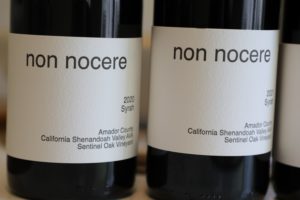 Peter produced his first rosé in 2016; it is a wine he takes very seriously, both in terms of grape sources and how it is made. He recalls he wasn’t able to drive during the 2016 harvest due to a broken foot, so a friend loaded up four 15-gallon kegs filled with grape juice in the back of a Subaru and drove them to his house. A thick stave Burgundian barrel also arrived, although he doesn’t remember who delivered it. But he does remember struggling to maintain his balance while standing on one leg (as a result of the broken foot) to reach the kegs to transfer the juice down to the barrel. He fermented the rosé in barrel; the fermentation ended up stalling, resulting in a sweet wine. We recall this also happened when we made our first wine while in high school from second crop Chardonnay and Pinot Noir grapes from Slusser Road in Sonoma County.
Peter produced his first rosé in 2016; it is a wine he takes very seriously, both in terms of grape sources and how it is made. He recalls he wasn’t able to drive during the 2016 harvest due to a broken foot, so a friend loaded up four 15-gallon kegs filled with grape juice in the back of a Subaru and drove them to his house. A thick stave Burgundian barrel also arrived, although he doesn’t remember who delivered it. But he does remember struggling to maintain his balance while standing on one leg (as a result of the broken foot) to reach the kegs to transfer the juice down to the barrel. He fermented the rosé in barrel; the fermentation ended up stalling, resulting in a sweet wine. We recall this also happened when we made our first wine while in high school from second crop Chardonnay and Pinot Noir grapes from Slusser Road in Sonoma County.
In 2017 he made a rosé at Dakota Shy but his winemaking was interrupted due to the 2017 fires. He made a rosé again in 2018 and was finally happy with the results, bottling it under the label, peter e. His first commercial rosé bottled as non nocere was in 2022. His rose is always made using the saignée method (bleeding off the juice from the crushed grapes).
The 2022 non nocere Rosé Napa Valley is a unique blend of 57% Cabernet Sauvignon, 29% Petite Sirah and 14% Cabernet Franc. The Cabernet Sauvignon and the Cabernet Franc were sourced from a historic vineyard in Oakville and the Petite Sirah is from Calistoga. All three varieties were on the skins for a short while with the juice then bled off to a 74 gallon stainless steel drum where primary fermentation occurred until the wine was dry. The wine was then racked from the drum into one 60 gallon newish French oak barrel. Peter employed heavy steam cleaning to remove the tannins and influence from the barrel staves. He likes the texture that the oak provides, rather than imparting overt ‘oak’ characteristics. His yeast of choice is a ‘workhorse’ as he calls it, wanting to ferment the wine as dry as possible.
This wine is medium to deep pink; the bouquet offers aromas of watermelon, cranberry and strawberry. Its flavors echo the bouquet to some extent including raspberries, strawberries, and watermelon. This latter aromatic reminded us of hiking in the summer in California’s high Sierra Nevada mountains and coming across snow covered with a pinkish algae. And this snow algae smells and tastes like watermelon, although we don’t recommend eating too much of it. The palate is brightly flavored and primarily red-fruited. This is a balanced and easy to drink wine which goes down far too easily. Its texture is lightly creamy and supple which is balanced nicely by its brightness of acidity. Any perceived sweetness is from the fruit rather than residual sugar as this wine was fermented to dryness. This wine was sterile filtered prior to bottling.
The 2023 non nocere Rosé Napa Valley is 63% Cabernet Franc, 22% Cabernet Sauvignon and 15% Petite Sirah. This wine is medium copper/salmon is color; the bouquet offers both a minerally character, fruit and floral scents; these include ruby grapefruit, raspberry and water poured on hot slate rock. The palate is brightly light yet also balanced by a pleasing texture that is lightly fleshy and supple from the entry through to the finish. Peter attributes this textural aspect to its time aging in the neutral barrel and also how he thoughtfully cleans the barrels before filling them. The palate mirrors the bouquet to some extent with flavors of raspberry, peach, grapefruit, kiwi and finger limes. It finishes on a lively pace with bright and mouth watering acidity accompanied by a subtle note of tarragon. Refreshing, this wine begs another sip. This is an elegant bottling. This wine is a ‘lighter’ expression, primarily due to the vintage (not an overly warm year). This wine did not go through malolactic fermentation; the secondary fermentation was arrested with the addition of 50 ppm sulpher added. In his winemaking, Peter never thinks of sulpher as being static; he is always looking for equilibrium between free and bound SO2.
In 2023, Peter began in part using bio-protectant non-saccharomyces yeast in all his fermentations, to prevent various spoilage bacteria including lactobacillus and inhibiting acetic acid. And when the residual sugar starts getting lower, finishing with a Fructophilic yeast to ensure dryness. Using these types of yeast has resulted in less usage of SO2. He changes the yeast strains depending on variety or vintage, based upon that vintage’s phenolic structure of the grapes.
Reds
Syrah

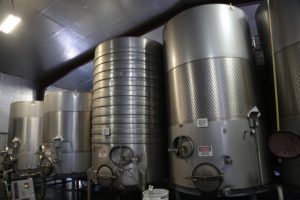
 In 2020 Peter spent time looking for Syrah and soon found an ad listing Amador County grown Syrah for sale. He called up the owner and discovered the grapes were being sold by Paul DiStefano, from his Sentinel Oak Vineyard within the Shenandoah Valley AVA. Paul first planted the site to Syrah in 1983 on their own roots; he still farms these original own-rooted vines. The vineyard is not fully dry farmed, but water use is kept to a minimum. Some are diseased (mostly Eutypa) but the vineyard still fully reaches ripeness every year. The property is at an elevation of around 1,500 feet and features Sierra coarse sandy loam soils. It is named after a particular giant blue oak growing on the property with an estimated aged of around 1,500 years.
In 2020 Peter spent time looking for Syrah and soon found an ad listing Amador County grown Syrah for sale. He called up the owner and discovered the grapes were being sold by Paul DiStefano, from his Sentinel Oak Vineyard within the Shenandoah Valley AVA. Paul first planted the site to Syrah in 1983 on their own roots; he still farms these original own-rooted vines. The vineyard is not fully dry farmed, but water use is kept to a minimum. Some are diseased (mostly Eutypa) but the vineyard still fully reaches ripeness every year. The property is at an elevation of around 1,500 feet and features Sierra coarse sandy loam soils. It is named after a particular giant blue oak growing on the property with an estimated aged of around 1,500 years.
As luck would have it, Paul was doing some errands in Napa Valley that week and brought down a 5 gallon bucket filled with bunches of Syrah he had recently harvested. Peter and some of his winemaker friends sampled the fruit; the price was right, the grapes tasted good, so he loaded up picking bins, drove up to the vineyard and harvested about 1.5 tons. But in the process of securing grapes, he wasn’t able to harvest as early as he wanted, which resulted in a riper expression of this variety in the bottle.
The 2020 non nocere Syrah Amador County, California Shenandoah Valley AVA, Sentinel Oak Vineyard; this wine is medium ruby in color; of the three vintages we tried, this is clearly the most fruit forward expression with aromas of blackberry, boysenberry, dark cherry, dark fig and and sweet chocolate. Within its fruit layers is a subtle floral character including of violets. The palate offers flavors of blueberry, cherry, dark plum, dark raspberry and dark licorice. The palate echoes the bouquet to a great extent with ripe but not over ripe fruit, an important distinction. The tannins are soft and rounded, comfortable in stature, with a light grainy character. They are fully mature. This wine finishes with a note of dark chocolate and layers of ripe fruit. And it is the highest alcohol of the three vintages; 15.9%. It is easy drinking, but of the Syrah from this vineyard produced to date, Peter admits this was the most challenging to craft in the cellar. This wine was fermented 1/3 whole cluster with the 2/3 destemmed but not crushed grapes added on top of the whole clusters in 1/2 ton plastic t-bins. The cap was broken several times a day and as it softened later in its fermentation, less punch downs were made. Peter bottles his red wines unfined and unfiltered and generally racks 2-3 times before bottling.
The 2021 non nocere Syrah Amador County, California Shenandoah Valley AVA, Sentinel Oak Vineyard is deep ruby and opaque with an amaranthine rim; the bouquet immediately offers a variety of darker spices, as a result of the influence of the barrel. These include crushed peppercorn, clove, cinnamon stick, a toasted oak woodsy spice accompanied by dark plum and blackberry. The darker fruits become more pronounced as the wine breathes and to some degree displace the spice characteristics. This wine is intensely flavored, layered and complex both in terms of its fruit and tannins. It is dark fruited including of plum and blackberry along with notes of blood orange, a character we noticed both this year and in 2022. The back of the palate offers notes of crushed peppercorn, a persistent dryness and a dried tobacco leaf which continues to persist. The dry character far outpaces the fruit at this age. Grainy and granular tannins fully coat the palate. The texture is an appealing attribute of this particular vintage; Peter describes their feel as fine as like cocoa powder. The finish lingers with a woodsy spice, dark pepper and roasted coffee beans.
Through his winemaking network in Napa Valley, Peter was introduced to Tonnellerie O. The company sources oak staves from numerous forests in France as well as select states in the U.S. Peter discovered that some of the staves came from forests in Pennsylvania, not far from where he grew up in Dubois. He contacted this cooperage and asked if they could make barrels entirely from Pennsylvania oak. They agreed and produced for the first time, several 70 gallon Pennsylvania grown oak barrels (10 gallons more than the typical 60 gallon Bordeaux barrels). He aged his 2021 and 2023 Syrah in these barrels. Quinn Roberts is the Master Cooper at Tonnellerie O, whose father Keith developed the 265L barrel at the now-defunct Mendocino Cooperage.
But there is more to the story. He was only able to harvest 0.345 tons of Syrah this year from the Sentinel Oak Vineyard due to a very bad frost that spring which resulted in a poor canopy cover. This was not ideal during the significant and sustained heat spike later that fall. As a result of this low tonnage the resulting wine was only 52 gallons after it was pressed, not even enough to fill a 60 gallon barrel. With 8 gallons of empty head space, Peter began to think of other material to add to the barrel. First he thought of marbles, but as he discovered, marbles are fairly expensive when needing 8 gallons of them. He looked at possibly stainless steel balls, but they were also expensive. So then he thought of adding local rocks. He drove to nearby Conn Creek in Rutherford and loaded up a number of alluvial and rounded river rocks. He then extensively pressure washed them. Not yet satisfied he had removed all surface carbonates, he soaked the rocks in citric acid (a common acid used in winemaking). By this time the rocks were as clean as he wanted and then added them to the wine to eliminate the remaining head space.
The 2022 non nocere Syrah Amador County, California Shenandoah Valley AVA, Sentinel Oak Vineyard; this wine is medium ruby in color. The aromatics sport notes of damp potting soil, a meaty character and white pepper along with darker fruits including plum and cherry. It reveals flavors of cherry and assorted berry fruits including dark raspberry, cherry cola, red plums, blood orange and red currant. The palate feels both fresh but also soft. The tannins are supple, and seamlessly fit on the finish. Their light touch is felt more on the front of the palate than the back. And this wine finishes with a subtle darker white pepper spice. This is a surprisingly elegant and pretty wine based on everything the grapes were subjected to during this particular vintage and also in the cellar. Because there were so few grapes for this wine, they only filled up about 1/3 of a 1/2 ton T-bin. As a result there was less extraction. For those looking for a lighter styled Syrah, this bottling would be a good fit. This wine was aged in a single Tonellerie Baron French oak barrel. The last Syrah produced by non nocere is from the 2023 vintage.
The 2023 non nocere Syrah, Amador County, California Shenandoah Valley AVA, Sentinel Oak Vineyard. This is the last vintage from this vineyard bottled under non nocere. Peter remembers loading the grapes onto a United Rental trailer, the axle bowed out and chains dragging on his way back to Napa Valley. The grapes were destemmed directly into bins for fermentation (no stem inclusion). This wine is medium purple in color; it smells fresh with floral layers including violets, dried rose petals and lavender. The first aromatic we noted was of red plum with additional layers including dark raspberry and cherry. Bright, fresh, and juicy. Balanced. Lively. Its flavors include red cherry, currant and cranberry. The tannins are pretty and linger with a well tumbled and approachable character in their youth. The resulting tannins from Syrah from this vineyard are consistent regardless of vintage, despite significant differences in alcohol. The finish is not overly spicy, but shows hints more towards being white pepper rather than dark. And lingers with a note of dust and chalk. A thread of bright acidity runs the length of the palate, leaving the finish fresh and mouth watering. This wine was aged in 56% French oak barrels and 44% American oak (Pennsylvania).
Petite Sirah
In 2022 non nocere began producing a 100% varietal Petite Sirah from the historic Pocai Vineyard in Calistoga, owned by the Ballentine family of Ballentine Winery. Beginning with the 2023 vintage, this Petite Sirah was aged entirely in American oak from Pennsylvania.
Here is a reminder to readers about the later part of the 2022 vintage in Napa Valley; a significant heat spell drove temperatures into the category of extreme for an extended period of time in early September. We recall parked in front of the Napa Valley Vintners sign near Calistoga and the thermometer in our car was 120 degrees, with both daytime highs over 115 degrees in parts of the valley and nighttime lows much higher than normal. Non nocere harvested their 2022 Petite Sirah two days into the heat spike. The brix shot up as the grapes were desiccating on the vines resulting in some inclusion of ‘raisins’ in the ferment and an even higher alcohol. Peter calls this harvest, ‘a hot ass vintage’. It certainly was.
The 2022 non nocere Petite Sirah, Pocai Vineyard Calistoga Napa Valley; the site shares a property line with Duckhorn’s Three Palms Vineyard. This wine is deep purple in color and opaque; the bouquet is ripe but perhaps not as ripe as we would have initially thought based on this variety and site. Peter describes this bouquet as having an, “aromatic impenetrability’. It is fruit forward with aromas of baked plums, dark plum, blackberry, dark mulberry, accompanied by darker florals including violets, lilacs and lavender. And there is a subtle meaty character similar to bacon fat that wants to evolve from the aromatics, but the fruit keeps it from doing so further. Juicy, mouth watering and lively, this is one of the more intriguing wines of this variety we have tried from Napa Valley north of 16% alcohol (listed as 16.1%). The palate is built on a core of fruit with flavors of plum, blackberry and dark cherry. The cocoa powdered tannins sport a surprisingly fine grained and polished texture both in terms of this being a young wine, and the variety. Their presence ultimately lingers beyond the fruit with a light drying and chalk-like character. The alcohol is very well managed; this is in no way a hot wine and we felt no ‘heat’ on the back of palate as we often do from higher alcohol bottlings that are out of balance.
The 2023 non nocere Petite Sirah, Pocai Vineyard, Calistoga Napa Valley (Block 10); this wine is deep ruby and opaque with an amaranthine rim. This wine is immediately floral with aromas of violets, lilacs, and lavender. But there are loads of fruit including dark plum, dark cherry, blueberry, blackberry and boysenberry with additional layers of baker’s chocolate, graham cracker and assorted darker baking spices. Flavorful without the overt intensity that sometimes this variety expresses, the palate tastes like black plum, dark cherry, boysenberry, blueberry and blackberry and tobacco spice. This wine offers a dense texture but with rounded and spherical shapes so that the texture never feels heavy. Fully coating, the tannins layer the entire palate with a long-lasting dusty and chalky character. This wine shows an impressive and long-lasting finish. This wine ripens correctly and evenly each vineyard he has worked with it, and can buffer with extra days of heat due to its high phenolic content. Peter describes this wine as continuing to unfurl forward, a resonant character resulting from its depth and layering. This variety is adept at expressing balance, despite its higher alcohol. This wine is a listed 15.3% ABV.
Cabernet Sauvignon
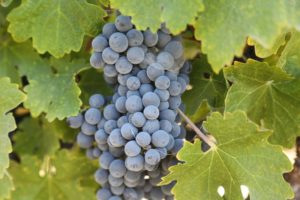 In 2023 non nocere produced its first Napa Valley Cabernet Sauvignon from the Turnbull Winery owned Fortuna Vineyard. The 2023 non nocere Cabernet Sauvignon, Fortuna Vineyard is 100% varietal from block 11 from clone 4 on 101-14 rootstock planted in 2008. This wine is deep ruby and nearly opaque; the first aromatic thread is dark and savory including dried herbs, old cedar box with some floral notes expressed as the wine evolves including of violets and rose petals. This wine needs some time to open as the nose is a little closed, but it opens its fruit core including of plum and raspberry. This is an attractive aromatic expression and is a lighter expression of the variety both on the nose and palate. Fresh, the palate is more focused on red fruits than dark with flavors of red cherry, currant, raspberry and Santa Rosa plum. The tannins fully coat the palate with a light to moderate textured gravelly and persistent dusty grip. They linger in tandem with a light red-fruited tart character. Not all Napa Valley Cabernet Sauvignon needs to be high octane. Enough said.
In 2023 non nocere produced its first Napa Valley Cabernet Sauvignon from the Turnbull Winery owned Fortuna Vineyard. The 2023 non nocere Cabernet Sauvignon, Fortuna Vineyard is 100% varietal from block 11 from clone 4 on 101-14 rootstock planted in 2008. This wine is deep ruby and nearly opaque; the first aromatic thread is dark and savory including dried herbs, old cedar box with some floral notes expressed as the wine evolves including of violets and rose petals. This wine needs some time to open as the nose is a little closed, but it opens its fruit core including of plum and raspberry. This is an attractive aromatic expression and is a lighter expression of the variety both on the nose and palate. Fresh, the palate is more focused on red fruits than dark with flavors of red cherry, currant, raspberry and Santa Rosa plum. The tannins fully coat the palate with a light to moderate textured gravelly and persistent dusty grip. They linger in tandem with a light red-fruited tart character. Not all Napa Valley Cabernet Sauvignon needs to be high octane. Enough said.
Peter hand labeled every bottle produced through the 2022 vintage, an extremely time consuming process. This resulted in labels not always being perfectly aligned.
—
Production varies every year with each bottling generally less than 200 cases with most of the wine sold direct to consumer. His first restaurant placement was R&G Lounge in San Francisco and later at Saison Cellar & Wine Bar and Corti Brothers in Sacramento. Locally the wines may also be available at V Wine Cellars in Yountville and at Deuces Market in Napa. With that said, Peter is looking for additional restaurants or retail wine shops within California to carry the wine. For more information, to signup for the mailing list or to purchase wine, visit: www.peterehopkins.com






Thank you so much, Dave! Very well articulated. Cheers.
For sure, please send to some of your customers and link back from your site.